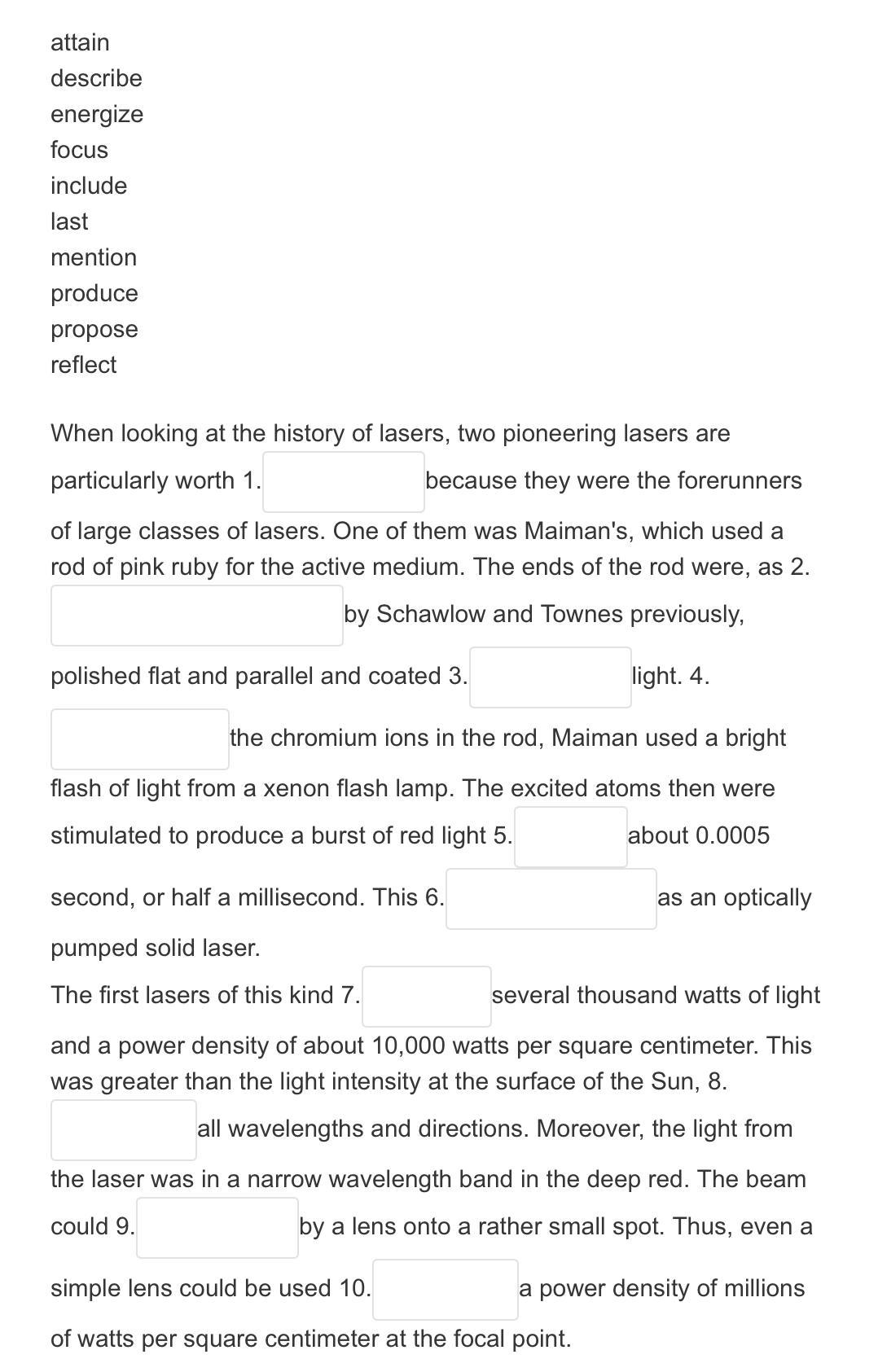ДАМ 20 БАЛЛОВ! Прошу, помогите!
Заполните пропуски глаголами, предложенными в списке. Преобразуйте грамматическую форму глаголов, согласуя их с контекстом.
Используйте каждый глагол только один раз.
Помните, глагол изменяется по категориям грамматического аспекта и времени, лица, числа, залога, наклонения; у глагола есть неличные формы глагола (инфинитив -- полный и неполный, герундий и причастие – действительного или страдательного залога)

Ответы
Ответ:
When looking at the history of lasers, two pioneering lasers are particularly worth 1) mentioning because they were the forerunners of large classes of lasers. One of them was Maiman's, which used a rod of pink ruby for the active medium. The ends of the rod were, as 2) proposed by Schawlow and Townes previously, polished flat and parallel and coated 3) to reflect light. 4) To energize the chromium ions in the rod, Maiman used a bright flash of light from a xenon flash lamp. The excited atoms then were stimulated to produce a burst of red light 5) lasting about 0.0005 second, or half a millisecond. This 6) was described as an optically pumped solid laser. The first lasers of this kind 7) produced several thousand watts of light and a power density of about 10,000 watts per square centimeter. This was greater than the light intensity at the surface of the Sun, 8) including all wavelengths and directions. Moreover, the light from the laser was in a narrow wavelength band in the deep red. The beam could 9) be focused by a lens onto a rather small spot. Thus, even a simple lens could be used 10) to attain a power density of millions of watts per square centimeter at the focal point.
Объяснение:
Рассматривая историю лазеров, обязательно стоит 1) упомянуть два новаторских лазера, потому что они были предшественниками больших классов лазеров. Одним из них был лазер Меймана, в котором в качестве активной среды использовался стержень из розового рубина. Концы стержня были, как 2) было предложено ранее Шавловым и Таунсом, отполированы до плоской и параллельной формы и на них было нанесено покрытие, 3) чтобы отражать свет. 4) Чтобы активировать ионы хрома в стержне, Мейман использовал яркую вспышку света от ксеноновой импульсной лампы. Возбужденные атомы затем стимулировали, чтобы произвести вспышку красного света, 5) длившуюся около 0,0005 секунды или полмиллисекунды. Это 6) было описано как твердотельный лазер с оптической накачкой. Первые лазеры этого типа 7) давали несколько тысяч ватт света и плотность потока энергии около 10 000 ватт на квадратный сантиметр. Это было больше, чем интенсивность света на поверхности Солнца, 8) включая все длины волн и направления. Более того, свет от лазера находился в узком диапазоне длин волн темно-красного цвета. Луч мог 9) фокусироваться линзой в довольно маленькое пятно. Таким образом, можно использовать даже простую линзу 10) для достижения плотности потока энергии в миллионы ватт на квадратный сантиметр в фокусе.
#SPJ1
When looking at the history of lasers, two pioneering lasers are particularly worth 1) mentioning because they were the forerunners of large classes of lasers. One of them was Maiman's, which used a rod of pink ruby for the active medium. The ends of the rod were, as 2) proposed by Schawlow and Townes previously, polished flat and parallel and coated 3) to reflect light. 4) To energize the chromium ions in the rod, Maiman used a bright flash of light from a xenon flash lamp. The excited atoms then were stimulated to produce a burst of red light 5) lasting about 0.0005 second, or half a millisecond. This 6) was described as an optically pumped solid laser. The first lasers of this kind 7) produced several thousand watts of light and a power density of about 10,000 watts per square centimeter. This was greater than the light intensity at the surface of the Sun, 8) including all wavelengths and directions. Moreover, the light from the laser was in a narrow wavelength band in the deep red. The beam could 9) be focused by a lens onto a rather small spot. Thus, even a simple lens could be used 10) to attain a power density of millions
of watts per square centimeter at the focal point